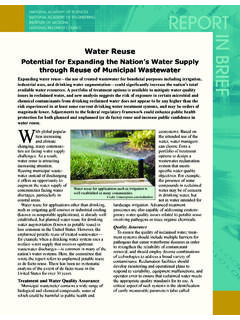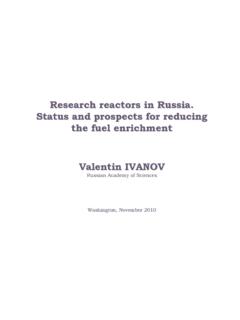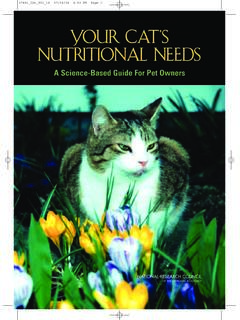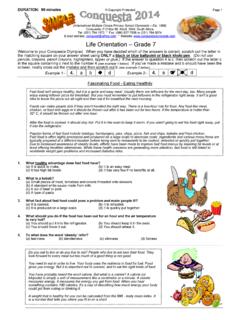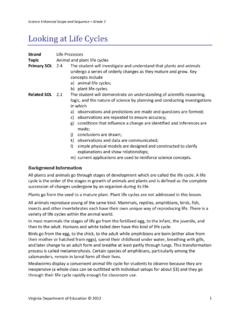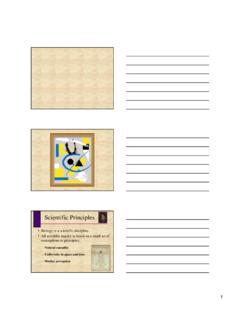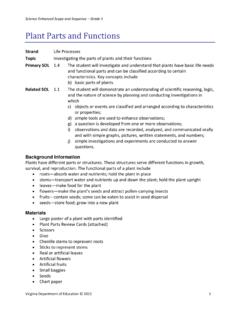Transcription of 37491 Dog P01 16 07/24/06 4:47 PM Page 1 YOUR DOG’S ...
1 YOUR DOG SNUTRITIONAL NEEDSA Science-Based Guide For Pet Owners37491_Dog_P01_16 07/24/06 4:47 PM Page 1liveresophagusspleencolonsmallintestine stomachPoint of DepartureThe mechanical breakdown of foodbegins in the mouth, where food isingested, chewed, and swallowed. Automatic TransportThe esophagus is a short,muscular tube in whichinvoluntary, wavelike con-tractions and relaxationspropel food from the mouthto the and ProcessingThe stomach acts as a temporary storage and processingfacility before emptying its contents into the small stages of digestion take place in the stomach wherepepsin and lipase aid in digesting protein and FacilitiesIn the small intestine, enzymes break down large, complex food moleculesinto simpler units that can be absorbed into the bloodstream.
2 The pan-creas is an organ that does double duty, secreting digestive enzymes intothe gut and hormones, including insulin and glucogon, into the for fat metabolism, the liver produces bile and partially stores itin the gall bladder between of the LineThe primary function of the largeintestine is to absorb electrolytesand water. Also, this is wheremicrobes ferment nutrients thathave so far escaped digestionand ON nutrient REQUIREMENTS OF DOGS AND CATSDONALD C. BEITZ, Chair, Iowa State University JOHN E. BAUER, Texas A&M University KEITH C. BEHNKE, Kansas State UniversityDAVID A. DZANIS, Dzanis Consulting & Collaborations GEORGE C. FAHEY, University Of Illinois RICHARD C.
3 HILL, University Of Florida FRANCIS A. KALLFELZ, Cornell University ELLEN KIENZLE, Zentrum F r Lebensmittel Und Tierern hrung, Oberschleissheim, Germany JAMES G. MORRIS, University Of California, Davis QUINTON R. ROGERS, University Of California, DavisSupport for this pamphlet was provided by the President s Circle Communications Initiative of theNational Academies. The pamphlet was written by Dale Feuer based on a report by the Committee onNutrient Requirements of Dogs and Cats. Illustration and design by Van of nutrient Requirements of Dogs and Catsare available from the National Academies Press,500 Fifth Street, , Washington, DC 20001; 800-624-6242 or 202-334-3313 (in the Washington area); 2006 by the National Academy of Sciences.
4 All rights DIGESTIVE TRACT37491_Dog_P01_16 07/24/06 4:47 PM Page 21 CONTENTSI ntroduction1 Proteins and Amino Acids2 Fats and Fatty Acids2 Energy Needs3 Vitamins6 Minerals8 Feeding Practices11 Food Choices12 INTRODUCTIONHow much should I feed my dog? Does the food I m providing meet my dog snutritional needs? As our knowledge of the relationship between diet andhealth continues to advance and as the range of foods available for dogs con-tinues to expand, it s more important than ever to base feeding choices ongood information. The information in this pamphlet is based on nutrient Requirements of Dogsand Cats, a technical report issued by the National Research Council as partof its Animal Nutrition Series.
5 The Food and Drug Administration relies oninformation in the report to regulate and ensure the safety of pet foods. Otherreports in the series address the nutritional needs of horses, dairy cattle, beefcattle, nonhuman primates, swine, and small ruminants. Scientists who studythe nutritional needs of animals use the Animal Nutrition Series to guidefuture research. The series is also used by animal owners, caretakers, andveterinarians to develop specialized diets for individual animals. Links toreports in the series can be found at 07/24/06 4:47 PM Page 12 Dogs need several different kinds of nutrients to survive: amino acidsfrom proteins, fatty acids and carbohydrates, vitamins, minerals,and water.
6 The tables in this pamphlet provide recommended dailyallowances for dietary nutrients based on the minimum amountrequired to maintain good health in normal dogs. Your dog s uniquenutritional requirements will depend on its size, its breed, and its stage in life,among other factors. A better understanding of how dogs use the various nutri-ents in food and how much of them they need can help you choose a healthierdiet for your NS AN D AMINO AC I DSDogs cannot survive without protein in their diets. Dietary protein contains 10specific amino acids that dogs cannot make on their own. Known as essen-tial amino acids, they provide the building blocks for many important bio-logically active compounds and proteins.
7 In addition, they donate thecarbon chains needed to make glucose for energy. High-quality pro-teins have a good balance of all of the essential amino show that dogs can tell when their food lacks a singleamino acid and will avoid such a are known to selectively choose foods that are high inprotein. Whether this is simply a matter of taste or a com-plex response to their biological needs for all 10 essentialamino acids is not known. However, dogs can survive ona vegetarian diet as long as it contains sufficient proteinand is supplemented with vitamin AND FATTY ACIDSD ietary fats, mainly derived from animal fats and the seedoils of various plants, provide the most concentratedsource of energy in the diet.
8 They supply essential fattyacids that cannot be synthesized in the body and serve ascarriers for important fat-soluble vitamins. Fatty acids play arole in cell structure and function. Food fats tend to enhancethe taste and texture of the dog s food as fatty acids are necessary to keep your dog s skin and coathealthy. Puppies fed ultralow-fat diets develop dry, coarse hair and skinlesions that become increasingly vulnerable to infections. Deficiencies inthe so-called omega-3 family of essential fatty acids may be associatedwith vision problems and impaired learning ability. Another family of essentialfatty acids called omega-6 has been shown to have important physiologiceffects in the 07/24/06 4:47 PM Page 23 ENERGY NEEDSDogs need a certain amount of energy to sustain the normal activities of their dailylives.
9 Growth, pregnancy, lactation, and exercise all increase these normal energyrequirements. Generally measured in terms of calories, energy comes from threemajor dietary components: carbohydrates, protein, and animals get some of their energy from carbohydrates, which includesugars, starches, and dietary fibers. The major sources of carbohydrates in com-mercial dog foods are cereals, legumes, and other plant foodstuffs. So-calledabsorbable carbohydrates, including glucose and fructose, can be directly absorbedand do not need to be digested by enzymes. Digestible carbohydrates are read-ily broken down by intestinal tract enzymes. Fermentable carbohydrates includecertain starches and dietary fibers that pass undigested through the small intes-tine to the colon, where they are fermented by microbes into short-chain fattyacids and gases.
10 Some studies suggest that fermentable fibers may aid in theregulation of blood glucose concentrations and enhance immune fibers, such as cellulose and wheat bran, contribute little interms of energy or nutrition and are primarily used to decrease caloric intake ofthe overweight RECOMMENDED ALLOWANCES FORPROTEIN AND FATSPUPPIES ADULT DOGS PREGNANT/NURSING DOGS(Weighing 12 lb, 33 lb at maturity)(Weighing 33 lb)(Weighing 33 lb with 6 puppies)Crude Protein56 g25 g69 g /158 gTotal Fat21 g14 g29 g / 67 gTIDBITS cientific research has shown that an adult dog s daily diet can contain up to50% carbohydrates by weight, including from fiber.

